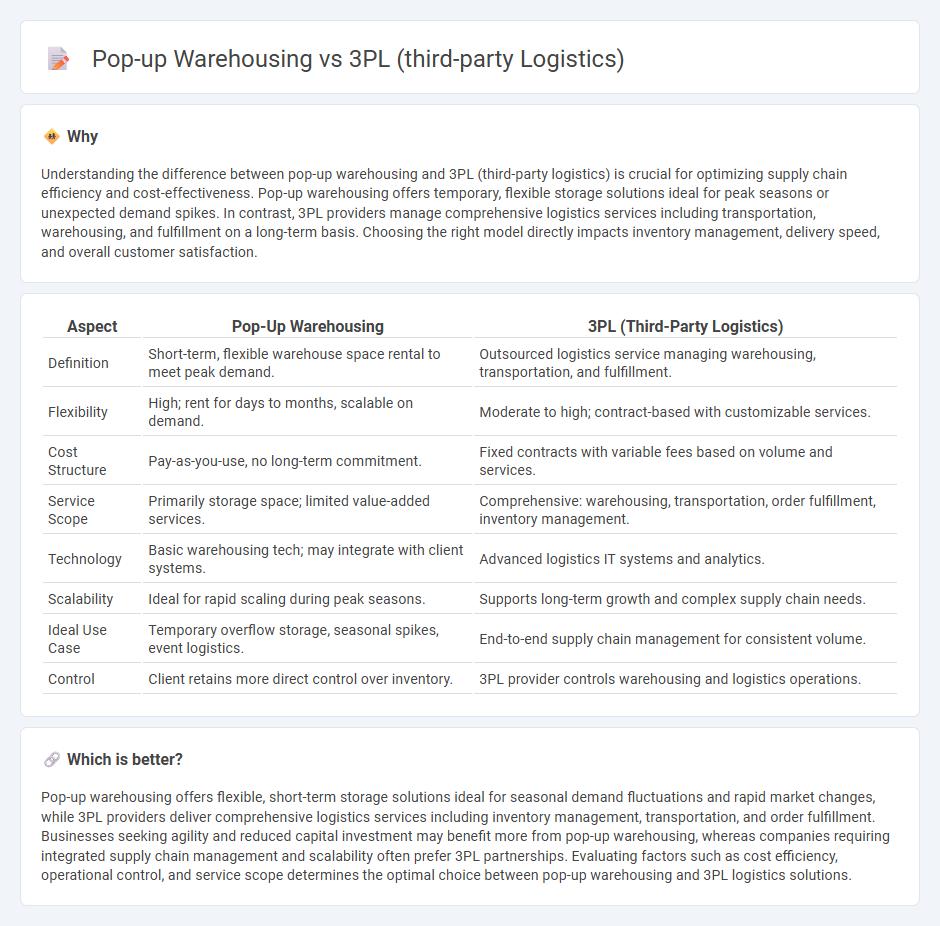
Pop-up warehousing offers flexible, short-term storage solutions tailored for fluctuating demand, while 3PL providers deliver comprehensive, long-term logistics services including inventory management, transportation, and fulfillment. Businesses leverage pop-up warehouses to quickly scale capacity during peak seasons, contrasting with 3PLs that handle end-to-end supply chain operations on a permanent basis. Explore the advantages and applications of pop-up warehousing versus 3PL to optimize your logistics strategy.
Why it is important
Understanding the difference between pop-up warehousing and 3PL (third-party logistics) is crucial for optimizing supply chain efficiency and cost-effectiveness. Pop-up warehousing offers temporary, flexible storage solutions ideal for peak seasons or unexpected demand spikes. In contrast, 3PL providers manage comprehensive logistics services including transportation, warehousing, and fulfillment on a long-term basis. Choosing the right model directly impacts inventory management, delivery speed, and overall customer satisfaction.
Comparison Table
| Aspect | Pop-Up Warehousing | 3PL (Third-Party Logistics) |
|---|---|---|
| Definition | Short-term, flexible warehouse space rental to meet peak demand. | Outsourced logistics service managing warehousing, transportation, and fulfillment. |
| Flexibility | High; rent for days to months, scalable on demand. | Moderate to high; contract-based with customizable services. |
| Cost Structure | Pay-as-you-use, no long-term commitment. | Fixed contracts with variable fees based on volume and services. |
| Service Scope | Primarily storage space; limited value-added services. | Comprehensive: warehousing, transportation, order fulfillment, inventory management. |
| Technology | Basic warehousing tech; may integrate with client systems. | Advanced logistics IT systems and analytics. |
| Scalability | Ideal for rapid scaling during peak seasons. | Supports long-term growth and complex supply chain needs. |
| Ideal Use Case | Temporary overflow storage, seasonal spikes, event logistics. | End-to-end supply chain management for consistent volume. |
| Control | Client retains more direct control over inventory. | 3PL provider controls warehousing and logistics operations. |
Which is better?
Pop-up warehousing offers flexible, short-term storage solutions ideal for seasonal demand fluctuations and rapid market changes, while 3PL providers deliver comprehensive logistics services including inventory management, transportation, and order fulfillment. Businesses seeking agility and reduced capital investment may benefit more from pop-up warehousing, whereas companies requiring integrated supply chain management and scalability often prefer 3PL partnerships. Evaluating factors such as cost efficiency, operational control, and service scope determines the optimal choice between pop-up warehousing and 3PL logistics solutions.
Connection
Pop-up warehousing complements third-party logistics (3PL) by providing flexible, temporary storage solutions that help 3PL providers manage fluctuating inventory demands and seasonal spikes efficiently. This synergy enhances supply chain agility, reduces last-mile delivery times, and optimizes overall inventory distribution across multiple geographic locations. Leveraging pop-up warehousing enables 3PL companies to scale their operations rapidly without significant capital investment in fixed infrastructure.
Key Terms
3PL (third-party logistics):
3PL (third-party logistics) providers offer comprehensive supply chain solutions, including transportation, warehousing, and inventory management, enabling businesses to outsource logistics functions efficiently. They leverage advanced technology and extensive networks to optimize shipping routes, reduce costs, and improve delivery speed. Discover how 3PL can transform your logistics strategy and drive operational excellence.
Outsourcing
Third-party logistics (3PL) providers specialize in comprehensive supply chain outsourcing, managing warehousing, transportation, and order fulfillment to enhance efficiency and reduce operational costs. Pop-up warehousing offers a flexible, temporary storage solution ideal for seasonal demand spikes without long-term commitments, focusing primarily on space rental rather than full logistics management. Explore how strategic outsourcing choices between 3PL and pop-up warehousing can optimize your logistics operations.
Integrated services
3PL providers offer comprehensive integrated services including transportation, warehousing, inventory management, and order fulfillment, streamlining supply chain operations under one management system. Pop-up warehousing focuses on temporary, flexible storage solutions that quickly adapt to fluctuating demand but may lack the full range of integrated logistics services provided by traditional 3PLs. Explore the differences and best applications of integrated logistics solutions by learning more about 3PL and pop-up warehousing.
Source and External Links
What is a 3PL? Third-Party Logistics Process Explained - A 3PL (third-party logistics) provider is a partner that helps businesses manage and optimize supply chain functions like inventory management, warehousing, order fulfillment, and transportation to streamline logistics and support growth.
What is 3PL (third-party logistics)? - A 3PL provider offers outsourced logistics services such as storage, shipping, and fulfillment, allowing companies to outsource facets of procurement and distribution to control costs and focus on their core activities.
How 3PLs Revolutionize Logistics and Supply Chain ... - Radial - 3PLs are specialized companies that businesses hire to outsource logistics and supply chain management tasks, providing services like transportation, warehousing, inventory management, and customs brokerage to improve efficiency and focus on core business.
 dowidth.com
dowidth.com